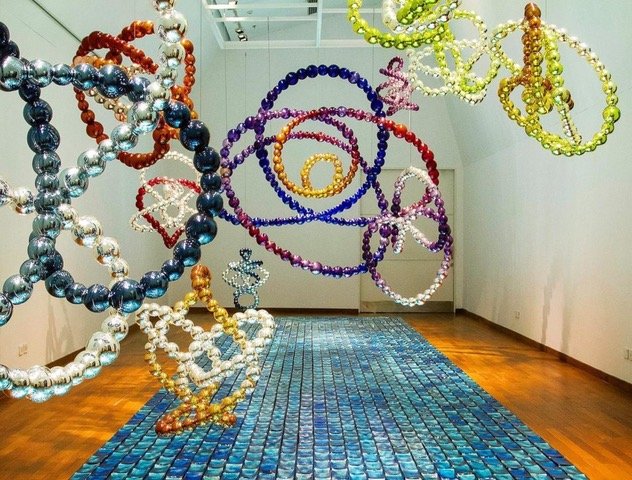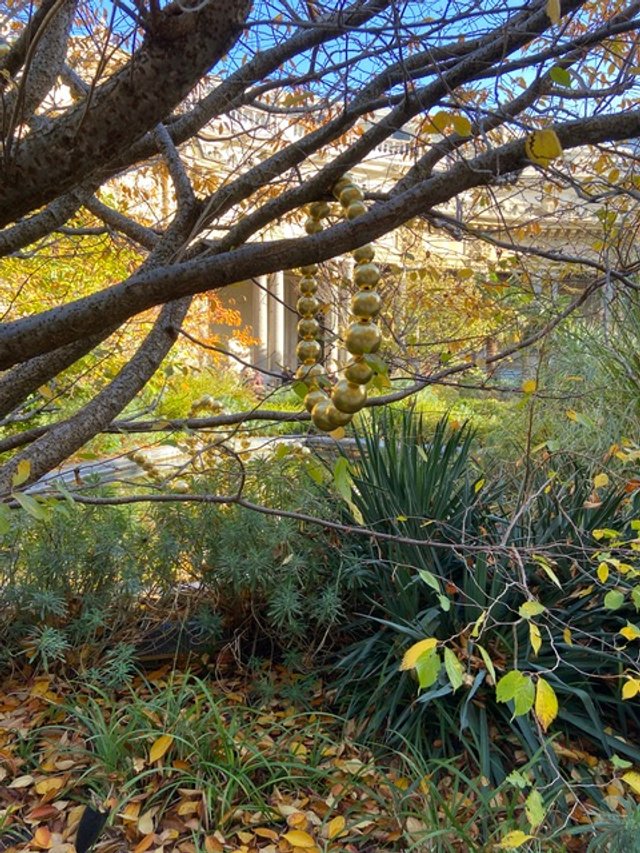All Tied Up In Knots
Jean-Michel Othoniel at the Petit Palais, Paris
If you are in Paris now, you simply MUST SEE Jean-Michel Othoniel installation at the Petit Palais. You know Othoniel’s work if you’ve ever walked by the metro at Palais Royale in Paris. Or if you’ve wandered by the Water Theatre grove in the gardens of the Chateau de Versailles. Or maybe you know Othoniel’s work closer to your home or farther away. Permanent installations are in Qatar and Brazil; New Orleans and San Francisco; Amsterdam and Shanghai, to name just a few. Most of Othoniel’s pieces are site specific, created to celebrate each location’s history, architecture and landscape.
When Othoniel was just starting out as an artist, he explored a range of media, from drawing to sculpture, photography to performance art. Materials which beckoned were those that could be transformed, like wax and sulphur. Then in 1993, he discovered glass. He didn’t become a glass blower himself, he began collaborating with glassblowers in Murano, Italy.
Glass doesn’t change while you watch it, except accidentally, of course, if it breaks. Its most dramatic changes happen at its creation, when sand metamorphoses into molten liquid and then into its hard but fragile, final form. But glass does interact with its setting, absorbing, reflecting, and diffusing light. It is in constant motion.
Othoniel must be an interesting client for the glassblowers with whom he works. Because he rejects what glassblowers normally strive for - perfection and regularity. Othoniel wants pieces that ‘bear traces of their creation’. He prefers “…to work with such accidents, asking the glassmakers to wound the glass before working on it…’ I feel exactly the same way, every time I see my son throw a beautifully imperfect piece into the overflowing reject bin at the glass studio. Glass tossed in the bin to be remelted, giving the glassblower a second chance to achieve perfection.
Othoniel’s first public commission was and continues to be a very high profile one. He was commissioned to create a new entrance to a Parisian metro station (Figure 1) to celebrate the Paris Metro system’s 100 year anniversary. You can see this structure, experience it, at the Palais-Royal metro stop. A double domed aluminum frame twinkles with blue and red glass baubles, which Othoniel calls cabochons (a French term for polished but not faceted gems). Othoniel named this piece Le Kiosque des Noctambules (Kiosk of the Night-Walkers).
Figure 1. Palais-Royal metro stop, Paris Jean-Michel Othoniel, 2000
An intricate silver waist high gate that looks like the cell structure of a plant, surrounds the stop on three sides. (Figure 2) At the back is a bench nearly hidden from view. (Figure 3) Especially useful, I suppose, for the people who wander the Paris streets at night, the Noctambules, the night owls, for whom Othoniel named the stop.
Figure 2. Palais-Royal metro stop, Paris Jean-Michel Othoniel, 2000
Figure 3. Palais-Royal metro stop, bench, Paris Jean-Michel Othoniel, 2000
I appreciate this structure now, although it seems awfully busy, with so many things to look at. I am not sure I would feel particularly at ease sitting here, at night, a little tipsy, trying to get my bearings. Perhaps Othoniel wasn’t sure he would get another public commission so he was trying to get in as much as he could. He needn’t have worried.
In 2014, Othoniel won an international competition to create a piece for the Water Theatre Grove in the gardens at the Chateau de Versailles. (Figure 4) It was the first permanent installation commissioned for the Chateau since Louis XVI. Othoniel collaborated with a landscape designer to create three fountain sculptures of gilded glass bulbs. The patterns of Othoniel’s glass bulbs may seem abstract and they are, of course, but they also refer to 17th-century ballet notations by Louis XIV’s ballet master, Roger-Auger Feuillet, (Figure 5) which Othoniel discovered at the Isabella Stewart Gardiner Museum in Boston. Othoniel recalled, “When I first saw them (the notations), they were so similar to my own sketches. They were exactly what I had been missing in my research. As a French artist, being asked to do this project was very moving, but also stressful. Those drawings formed the connection for me.’
Figure 4. Les Belles Danses, Théâtre d’Eau, Versailles. Jean-Michel Othoniel, 2014
Detail of above
Figure 5 Ballet Notations, Roger-Auger Feuillet, Louis XIV’s Ballet Master
Othoniel’s sculptures pay homage to Louis XIV and his landscape designer, his paysagiste, André Le Nôtre. The commissioner and designer, respectively, of the gardens at Versailles. The most significant difference between Othoniel’s fountains and Le Nôtre’s 17th century design? The audience. Othoniel said, “This is my republican project…This fountain is literally for the public. It serves the people.”
In San Francisco, the following year, Othoniel created a kinetic sculpture called La Rose des Vents (compass) of gold and aluminum, (Figure 6) an homage to the Compass Rose, an ancient device which gauged wind direction. Intended as a temporary display, the sculpture was bought and then gifted to San Francisco. Which is never a simple process. But it is now, after City Hall and Covid 19 delays, installed in front of the Conservatory of Flowers in Golden Gate Park, shimmering in the sun and shifting with the breeze. When my daughter was there a few weeks ago, a man stepped over the fence and walked right up, gave it a push and set it spinning. I don’t think that is the recommended level of community involvement, but it did look beautiful as it lazily spun under a cloudless blue sky, on an almost too warm day in November, in San Francisco. (Figure 7)
Figure 6. La Rose des Vents, Conservatory of Flowers, San Francisco, Jean-Michel Othoniel, 2015
Figure 7. La Rose des Vents, Conservatory of Flowers,(11/2021) San Francisco, Jean-Michel Othoniel, 2015
Othoniel is seriously interested in flower symbolism. He wrote The Secret Language of Flowers: Notes on the Hidden Meanings of Flowers in Art, in 2012 about the flowers in Isabelle Stewart Gardener’s art collection which he studied during a year long residency. A rose, he explained, symbolizes beauty and the power of love to conquer death.
Othoniel’s described his enthusiasm for this project this way, “(H)aving the chance to show La Rose des Vents in this amazing location truly links my work to the City, connecting my sculpture with the history of flowers, while the movement of the artwork, responding to the changing of the Bay Area weather, aligns the golden surface of the sculpture with the spirit of the Golden Gate”.
Figure 8. Petit Palais, Paris, 1900, entrance
Othoniel at the Petit Palais is a perfect exhibition for a perfect place. (Figure 8) Built for the 1900 Universal Exhibition (as was the Grand Palais across the street), it is a sumptuous structure. Now a museum, lots of fabulous paintings like Pierre Bonnard’s portrait of Ambroise Vollard (Figure 9) and Gustave Courbet’s Sleep (Figure 10) are here. Like all museums owned by the City of Paris, the permanent collection is always free. You only have to pay for temporary exhibits. Except for this one which is free. The artist has also donated a work from the exhibition to become part of the permanent collection. A piece whose measurements are perfect for the space. (Figure 11)
Figure 9. Portrait of Ambroise Vollard, Pierre Bonnard, 1024
Figure 10. The Sleepers, Gustave Courbet, 1866
Figure 11. Othoniel’s gift to Petit Palais, 2021
Othoniel explained the thinking behind his exhibition this way, “I asked myself, ‘What’s the Mona Lisa of the Petit Palais, what’s the masterpiece?’ and finally, I realized that the masterpiece is the architecture itself. So I created a dialogue between my sculptures and this machine of dreams.” He is right, the architecture of the Petit Palais is beautiful inside and out. But for me, Onthoniel’s sculptures in the garden are the most joyful. (Figure 12) In the space that makes me the happiest.
Figure 12. Petit Palais garden, with Jean-Michel Othoniel
The title of the exhibition, “The Narcissus Theorem,” is a reference of course, to Narcissus, son of a river god and nymph, who was so transfixed by his own reflection in a pool of water that he couldn’t think about anything else. (Figure 13) Not the nymph Echo who pursued him or the guy who did either. Narcissus died either from drowning or starvation, sources vary. At his death, Narcissus was transformed into a flower, a narcissus, a daffodil.
Figure 13, Narcissus staring at his reflection, Caravaggio, 1594
The exhibition begins outside, on the grand stairway leading up to the elegant main entrance. (Figure 14) Visitors are greeted by a cascading sea of 1,000 aquamarine colored glass bricks, the “Blue River”. Another river of blue glass bricks decorates the large exhibition space on the ground floor. (Figure 15) The artist’s most well known sculptures are his necklaces and crowns and whips and lassos of colorful mirror-glass balls. There is a profusion of them in various spaces inside the museum. (see above) Gold and silver balls are scattered throughout the interior (Figure 16) and in the garden, some above pools of water, (Figure 17) others suspended in trees (Figure 18), others scattered around the courtyard. (Figure 19)
Figure 14. Blue River, Petit Palais entrance, Jean-Michel Othoniel
Figure 15. Blue River interior, Petit Palais, Jean-Michel Othoniel
Figure 16. Petit Palais interior, Jean-Michel Othoniel
Figure 17. Petit Palais, garden, Jean-Michel Othoniel
Figure 18. Petit Palais garden, Jean-Michel Othoniel
Figure 19. Petit Palais courtyard, Jean-Michel Othoniel
As you might imagine, there’s a lot of reflection going on in this exhibition. There are all those reflective multi-colored glass bubbles strung together in chains and circles. Then there are stainless steel mirrored balls and pedestals with lots of reflection possibilities (Figure 20). The seeing yourself in the mirror kind, not the thinking about your life kind. Well, at least not necessarily. The reflections keep changing, depending upon the observer’s viewpoint and the amount of light filtering into the space. All these permutations reflect Othoniel’s own interest in transformations and of course play with the myth of Narcissus, staring at his own reflection and then his transformation after death.
Figure 20. Stainless steel mirrored balls, Petit Palais, Jean-Michel Othoniel
And then there are the Wild Knots which Othoniel has been working on with the Mexican mathematician Aubin Arroyo since 2015. Their collaboration started this way. In 2011, a friend of Arroyo’s showed him images of Othoniel’s exhibition at the Pompidou. Arroyo was struck by Othoniel’s knots, which the artist was then calling nodes. Othoniel’s source for his nodes was the French psychoanalyst Jacques Lacan, who used Borromean rings as a way to express or conceptualize the intersection between the imaginary, the symbolic and the real. (Figure 21)
Figure 21. Borromean rings
Arroyo was struck by the similarity between Othoniel’s nodes (Figure 22) and the computer visualizations of his own theorems of wild knots. (Figure 23) According to Arroyo, “The study of the infinite repetition of some simple rules, such as reflections in a mirror, shows us different representations of infinity. … (With) reflective sphere necklaces, all these infinities draw a curve that is infinitely knotted…a wild knot.” Complicated stuff with which Othoniel obviously loves to play around. After you see this exhibition, take a look at Arroyo’s Recipe for a Wild Knot here . My son took a course at art school (required) on Math for Artists. It was filled with all sorts of connections like this. He found it inspiring. You will too.
Figure 22. Wild Knots, Jean-Michel Othoniel
Figure 23. Wild Knots, Aubin Arroyo & Jean-Michel Othoniel
Copyright © 2021 Beverly Held, Ph.D. All rights reserved
Dear Reader, I hope you enjoyed reading this article. Please click here or sign up below to receive more articles plus other original content from me, Dr. B. Merci!
And, if you enjoyed reading this review, please consider writing a comment. Thank you























